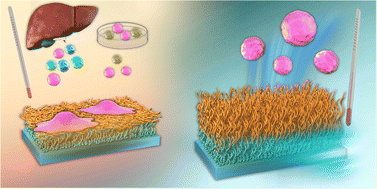Thermoresponsive block copolymer brush for temperature-modulated hepatocyte separation†
Abstract
Hepatic tissue engineering may be an effective approach for the treatment of liver disease; however, its practical application requires hepatic cell separation technologies that do not involve cell surface modification and maintain cell activity. In this study, we developed hepatocyte cell separation materials using a thermoresponsive polymer and a polymer with high affinity to hepatocytes. A block copolymer of poly(N-p-vinylbenzyl-O-β-D-galactopyranosyl-(1→4)-D-gluconamide) (PVLA) and poly(N-isopropylacrylamide) (PNIPAAm) [PVLA-b-PNIPAAm] was prepared through two steps of atom transfer radical polymerization. On the prepared PVLA-b-PNIPAAm brush, HepG2 cells (model hepatocytes) adhered at 37 °C and detached at 20 °C, attributed to the temperature-modulated affinity between PVLA and HepG2. Cells from the immortalized human hepatic stellate cell line (TWNT-1) did not adhere to the copolymer brush, and RAW264.7 cells (mouse macrophage; model Kupffer cells) adhered to the copolymer brush, regardless of temperature. Using the difference in cell adhesion properties on the copolymer brush, temperature-modulated cell separation was successfully demonstrated. A mixture of HepG2, RAW264.7, and TWNT-1 cells was seeded on the copolymer brush at 37 °C for adherence. By reducing the temperature to 20 °C, adhered HepG2 cells were selectively recovered with a purity of approximately 85% and normal activity. In addition, induced pluripotent stem (iPS) cell-derived hepatocytes adhered on the PVLA-b-PNIPAAm brush at 37 °C and detached from the copolymer brush at 20 °C, whereas the undifferentiated iPS cells did not adhere, indicating that the prepared PVLA-b-PNIPAAm brush could be utilized to separate hepatocyte differentiated and undifferentiated cells. These results indicated that the newly developed PVLA-b-PNIPAAm brush can separate hepatic cells from contaminant cells by temperature modulation, without affecting cell activity or modifying the cell surface. Thus, the copolymer brush is expected to be a useful separation tool for cell therapy and tissue engineering using hepatocytes.



 Please wait while we load your content...
Please wait while we load your content...